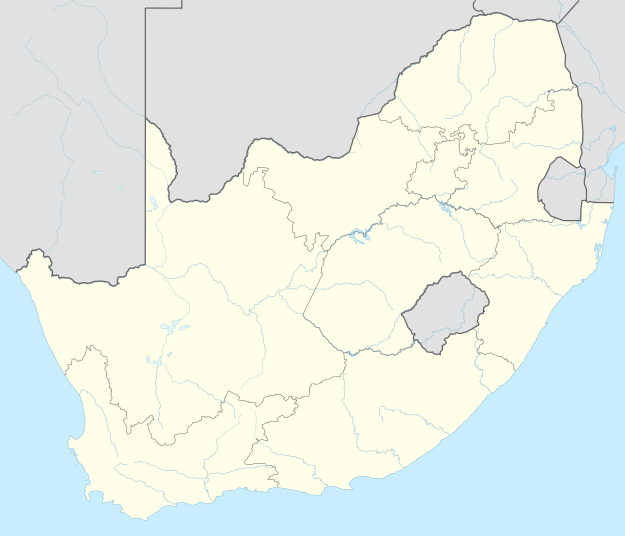Clocolan
Clocolan, established in 1906, is a small town in the Free State Province of South Africa. The Basotho called the place Hlohlolwane (Hlohla-o-lwane, "get up and fight"). New inhabitants mispronounced the name and called it Clocolan.
Clocolan | |
|---|---|
 Clocolan  Clocolan | |
| Coordinates: 28°54′50″S 27°34′01″E | |
| Country | South Africa |
| Province | Free State |
| District | Thabo Mofutsanyane |
| Municipality | Setsoto |
| Area | |
| • Total | 19.0 km2 (7.3 sq mi) |
| Population (2011)[1] | |
| • Total | 17,602 |
| • Density | 930/km2 (2,400/sq mi) |
| Racial makeup (2011) | |
| • Black African | 95.7% |
| • Coloured | 0.3% |
| • Indian/Asian | 0.3% |
| • White | 3.6% |
| • Other | 0.1% |
| First languages (2011) | |
| • Sotho | 86.4% |
| • English | 5.3% |
| • Afrikaans | 5.2% |
| • Sign language | 1.8% |
| • Other | 1.3% |
| Time zone | UTC+2 (SAST) |
| Postal code (street) | 9735 |
| PO box | 9735 |
| Area code | 051 |
History
The first to inhabit the area were the ancient Kwena people from Botswana. Soon the Basotho followed. The town developed as surrounding communities needed a school, a church and business facilities . The Bakwena, a Sotho tribe, gave Clocolan its name in 1800. The Bakwena Chief Motebang lived in the Northern part of Clocolan, in an area known as ‘Betang’, today a private farm. Motebang invited the neighbouring Baphuthi Zulu clan to assist his people stacking corn baskets after a successful harvest. An argument erupted when one Bakwenaelder charged at the Baphuti's. The argument brought forth the slogan ‘Hlohla-o-loane’ or ‘Hlohloloane’, that translates as “Get/stand up and fight” and this may explain how the town earned its name. Settlers in the early 1800s drove the Basotho out of town, forming a township still known as Hlolholoane.
Geography
The town is in the Thabo Mofutsanyana region of the Free State Province in South Africa.[2] It is located along the Maloti route main road, 20 kilometers from the Caledon river, alongside the Lesotho border. Due to its location, the town trades with Lesotho, Southern parts of the Free State, Kwa-Zulu Natal and the Cape.[3]
Location
Clocolan is situated along the R26 about 34km from Ficksburg to the northeast and just under 70km from Maseru to the south over the Lesotho border. The name is derived from the Hlohlolwane mountain which stands 1 820km above sea level. Hlohlolwane means “stand-up-and-fight” which refers to an altercation between the Koena tribe and Baphuthini over a maize harvest.[4] The town was established in 1906 on the farms of Reinzi and Herold. The town grew out of the need for schools, churches and business services for the surrounding farming community. It obtained municipal status on 18 July 1910.[5] The eastern Free State cherry industry originated in the Clocolan district where the first trees were planted by Henry Pickstone in 1904 on the farm Platkop.[6] Besides cherry orchards, farming in the area predominantly consists of asparagus, wheat, maize, potatoes and cattle. Clocolan has one industrial area, situated in the eastern side of the town close to the railway line.[7]
Farming
The area is known for the cultivation of wheat, maize, cherries, large cattle and sheep herds.[8]
Tourism
Tourists can visit the following places:
- Deemsters Asparagus Factory to learn about the history of this local crop
- Nebo and Die Hoek where visitors can view San rock art paintings
- Tandjiesberg rock shelter has rock paintings and was declared a National Monument on 30 October 1992. It was one of 12 rock art National Monuments in South Africa at the time and is now a Provincial Heritage Site. The rock art painting includes one of an elephant with a small human figure on its trunk. There are also paintings of animals associated with rainmaking and images of a medicine dance. Archaeological excavations established that Bushmen lived here for at least 1 000 years. It is believed that the mountain above the rock shelter was a place of spiritual significance.[9][10]
- Lethoteng Weavers – a community project involving the weaving of articles by local craftswomen including jerseys, scarves, carpets and other items from Angola Rabbit, Mohair and wool.[11]
Vintage Tractor and Engine Fair
The Vintage Tractor and Engine Fair is an annual fair that has taken place in Clocolan since 1989. The fair started with only 29 tractors and has grown in recent years to 153 . Tractors are paraded through the small farming community. Some of its attractions are a 1902 threshold machine, the Annual National Ploughing Championships and a hand plowing with magnificent Nguni bulls.[12]
In popular culture
The name is used by recording artist clocolan—South African-born composer Emlyn Ellis Addison.[13]
References
- Sum of the Main Places , and from Census 2011.
- "Clocolan Travel Information". www.free-state-info.co.za. Retrieved 2018-10-26.
- "Town History | Setsoto Local Municipality". www2.setsoto.info. Retrieved 2018-10-26.
- "Clocolan: Thabo Mofutsanyana". South Africa explored. Retrieved 7 January 2018.
- "Town History". Setsoto Municipality. Retrieved 7 January 2018.
- Olivier, Willie; Olivier, Sandra (2001). Touring in South Africa. Cape Town: Struik Publishers. p. 114.
- "Town History". Setsoto Municipality. Retrieved 7 January 2018.
- "Clocolan Tourism - Things to do in Clocolan - Discover South Africa". www.discoversouthafrica.co.za. Retrieved 2018-10-26.
- Philip, Harrison; Heese, Sue (2006). South Africa’s top sites: Family. Kenilworth: Spearhead. p. 127. ISBN 9780864865830.
- "Shelter with Rock Paintings, Tandjiesberg, Clocolan District". SAHRIS. Retrieved 26 January 2018.
- "Clocolan: Thabo Mofutsanyana". South Africa explored. Retrieved 7 January 2018.
- "Vintage Tractor Fair". www.sa-venues.com. Retrieved 2018-10-26.
- "clocolan.space". Artist website. Retrieved 7 February 2018.
External Links
- http://www.free-state-info.co.za/provinces/town/452/clocolan
- https://www.sa-venues.com/attractionsfs/clocolan.php
- http://www2.setsoto.info/town-history
- https://showme.co.za/south-africa/free-state/eastern-free-state/clocolan/
- http://www.nasmus.co.za/departments/rock-art/public-rock-art-sites
- http://www.sahra.org.za/sahris/sites/923080001
- https://web.archive.org/web/20180817070727/http://prynnsberg.co.za/history-1881/
- http://www.savtec.co.za/
.svg.png)